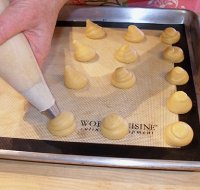 What is a Piping Bag?
What is a Piping Bag?
A pastry bag (or piping bag) is an often cone- or triangular-shaped, hand-held bag made from different pliable and food safe materials that is used to pipe semi-solid foods by pressing them through a narrow opening at one end, fitted with or without a piping tip. It is used for many purposes including cake decoration. It is filled through a wider opening at the opposite end, rolled or twisted closed, and then squeezed to extrude its contents.
Pastry or decorating tips, in either metal or plastic, fit in the pastry bag through a hole in its narrow opening at one end. They can be optionally locked into place using a coupler. These tips are used to decorate cakes and cookies with frosting, chocolate or whipped cream, pipe dough and cream fillings to fill cupcakes or pastries with.
SARAH SAYS: You can frost cake layers using a pastry bag.
Decorating tips come in so many different shapes and sizes; choosing one can be confusing because there’s no standardized sizing system among manufacturers. They are generally titled according to their style and size with letters or numbers. Popular ones include round tips, star tips, petal tips and basket-weave tips.
A coupler is a two-part device (base and a ring) that lets you interchange several decorating tips without changing the pastry bag. The base fits inside the bag, then you put the decorating tip of your choice over the portion of the coupler that sticks out of the bag. The decorating tip is locked into place when you when you screw the ring on. Go to: How to use a coupler.
EXTRAS:
- How to Assemble and Fill a Pastry or Piping Bag
- How to Pipe Using a Pastry or Piping Bag
- How to Make Your Own Parchment Paper Cone for Piping
- How to Fill and Pipe with Your Parchment Paper Cone
Types of Pastry or Piping Bags
Pastry bags come in varying types and sizes. Chose the one that fits your hand comfortably and works best for you without warming the contents in the bag while you are using it.
SARAH SAYS: I like to make sure I have a couple of sizes on hand to handle all of my decorating and baking tasks. I prefer to use disposable bags because they are easy to use and dispose of, but the plastic-lined cloth bags are good, too, and more environmentally friendly.
| TYPE | ATTRIBUTES | SARAH SAYS | RECIPE EXAMPLE |
| Canvas bags | Tend to be heavy, but are pliable and maneuverable; and, are great for working with stiff doughs and purées. Also great when working with warm ingredients. | These bags tend to stain over time with tinted fillings. Hard to clean, and takes overnight (or longer) to dry, hanging it upside down. | Pate a Choux Dough and Filled Cream Puffs Recipe Tutorial |
| Disposable plastic bags | Versatile and easy to use. You cut the tip off with scissors to fit whatever sized piping tip or opening you want; They make for the easiest clean-up because they are disposable. | We find these to be the most versatile, but they can get expensive to use over time. | Vanilla Orange Frozen Yogurt Push Up Pops |
| Nylon bags | Are light and comfortable to use, and easy to clean, but tend to be less durable than cloth bags | They are not totally maneuverable to us, and become slippery when wet. | |
| Parchment pastry cones | This disposable paper cone (or triangle) allows you to pipe intricate designs and decorations. | We use these when piping small amounts of frosting or icing (about 1/4 cup) for decorating, melted candy melts or chocolate, or even batter for a design. They are great for a one-time use. | Arabesque Patterned Sponge Cake Shapes |
| Plastic-lined cloth bags | Can be used to manage the heavy-duty tasks. Their plastic lining makes them easy to clean. | This pastry bag is somewhat light, thus not feeling to us as our having as much control over their handling. | Black Cherry Forest Cake |
| Plastic Squeeze Bottle | Great to use for decorating cookies with. Can be fitted with a tip. | We like to use this when outlining and filling in larger areas of a cookie. Easy to clean. | Cookie Decorating Tutorial 2 |
How to Use a Piping Bag
Care
- Take off the coupler and piping tip, and squeeze as much of the unused pastry bag contents back into its mixing bowl or storage container.
- Handwash reusable bags, couplers and tips immediately with warm soapy water. Take care not to soak the metal tips for a long time because they tend to rust. Towel-dry tips and allow them to air-dry.
- If a bag has a loop, hang it to dry. Otherwise, stand it on its open wide end so the tip side is up to dry.
- If stored before thoroughly dry, some bags may mold and metal tips may rust, and they cannot be used again.


